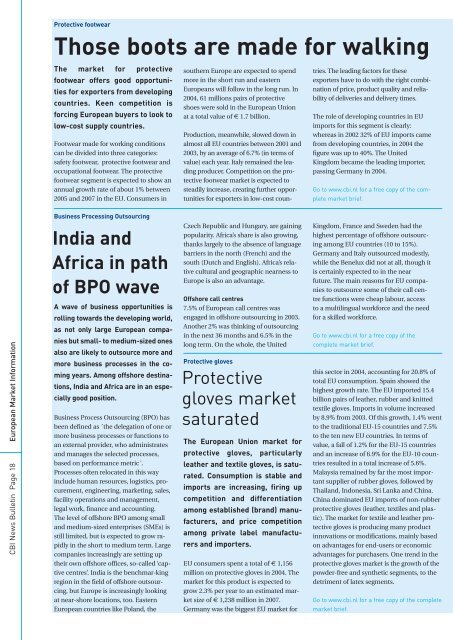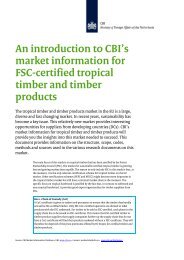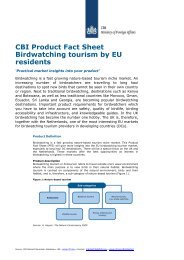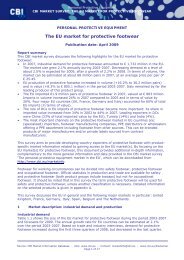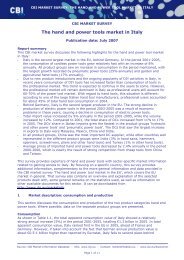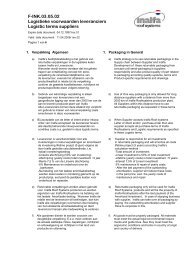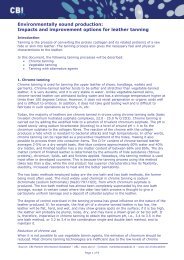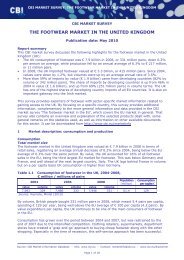CBI News Bulletin November / December 2005
CBI News Bulletin November / December 2005
CBI News Bulletin November / December 2005
Create successful ePaper yourself
Turn your PDF publications into a flip-book with our unique Google optimized e-Paper software.
<strong>CBI</strong> <strong>News</strong> <strong>Bulletin</strong> Page 18 European Market Information<br />
Protective footwear<br />
Those boots are made for walking<br />
The market for protective<br />
footwear offers good opportunities<br />
for exporters from developing<br />
countries. Keen competition is<br />
forcing European buyers to look to<br />
low-cost supply countries.<br />
Footwear made for working conditions<br />
can be divided into three categories:<br />
safety footwear, protective footwear and<br />
occupational footwear. The protective<br />
footwear segment is expected to show an<br />
annual growth rate of about 1% between<br />
<strong>2005</strong> and 2007 in the EU. Consumers in<br />
Business Processing Outsourcing<br />
India and<br />
Africa in path<br />
of BPO wave<br />
A wave of business opportunities is<br />
rolling towards the developing world,<br />
as not only large European companies<br />
but small- to medium-sized ones<br />
also are likely to outsource more and<br />
more business processes in the coming<br />
years. Among offshore destinations,<br />
India and Africa are in an especially<br />
good position.<br />
Business Process Outsourcing (BPO) has<br />
been defined as ´the delegation of one or<br />
more business processes or functions to<br />
an external provider, who administrates<br />
and manages the selected processes,<br />
based on performance metric´.<br />
Processes often relocated in this way<br />
include human resources, logistics, procurement,<br />
engineering, marketing, sales,<br />
facility operations and management,<br />
legal work, finance and accounting.<br />
The level of offshore BPO among small<br />
and medium-sized enterprises (SMEs) is<br />
still limited, but is expected to grow rapidly<br />
in the short to medium term. Large<br />
companies increasingly are setting up<br />
their own offshore offices, so-called ‘captive<br />
centres’. India is the benchmar-king<br />
region in the field of offshore outsourcing,<br />
but Europe is increasingly looking<br />
at near-shore locations, too. Eastern<br />
European countries like Poland, the<br />
southern Europe are expected to spend<br />
more in the short run and eastern<br />
Europeans will follow in the long run. In<br />
2004, 61 millions pairs of protective<br />
shoes were sold in the European Union<br />
at a total value of € 1.7 billion.<br />
Production, meanwhile, slowed down in<br />
almost all EU countries between 2001 and<br />
2003, by an average of 6.7% (in terms of<br />
value) each year. Italy remained the leading<br />
producer. Competition on the protective<br />
footwear market is expected to<br />
steadily increase, creating further opportunities<br />
for exporters in low-cost coun-<br />
Czech Republic and Hungary, are gaining<br />
popularity. Africa’s share is also growing,<br />
thanks largely to the absence of language<br />
barriers in the north (French) and the<br />
south (Dutch and English). Africa’s relative<br />
cultural and geographic nearness to<br />
Europe is also an advantage.<br />
Offshore call centres<br />
7.5% of European call centres was<br />
engaged in offshore outsourcing in 2003.<br />
Another 2% was thinking of outsourcing<br />
in the next 36 months and 6.5% in the<br />
long term. On the whole, the United<br />
Protective gloves<br />
Protective<br />
gloves market<br />
saturated<br />
The European Union market for<br />
protective gloves, particularly<br />
leather and textile gloves, is saturated.<br />
Consumption is stable and<br />
imports are increasing, firing up<br />
competition and differentiation<br />
among established (brand) manufacturers,<br />
and price competition<br />
among private label manufacturers<br />
and importers.<br />
EU consumers spent a total of € 1,156<br />
million on protective gloves in 2004. The<br />
market for this product is expected to<br />
grow 2.3% per year to an estimated market<br />
size of € 1,238 million in 2007.<br />
Germany was the biggest EU market for<br />
tries. The leading factors for these<br />
exporters have to do with the right combination<br />
of price, product quality and reliability<br />
of deliveries and delivery times.<br />
The role of developing countries in EU<br />
imports for this segment is clearly:<br />
whereas in 2002 32% of EU imports came<br />
from developing countries, in 2004 the<br />
figure was up to 40%. The United<br />
Kingdom became the leading importer,<br />
passing Germany in 2004.<br />
Go to www.cbi.nl for a free copy of the complete<br />
market brief.<br />
Kingdom, France and Sweden had the<br />
highest percentage of offshore outsourcing<br />
among EU countries (10 to 15%).<br />
Germany and Italy outsourced modestly,<br />
while the Benelux did not at all, though it<br />
is certainly expected to in the near<br />
future. The main reasons for EU companies<br />
to outsource some of their call centre<br />
functions were cheap labour, access<br />
to a multilingual workforce and the need<br />
for a skilled workforce.<br />
Go to www.cbi.nl for a free copy of the<br />
complete market brief.<br />
this sector in 2004, accounting for 20.8% of<br />
total EU consumption. Spain showed the<br />
highest growth rate. The EU imported 15.4<br />
billion pairs of leather, rubber and knitted<br />
textile gloves. Imports in volume increased<br />
by 8.9% from 2003. Of this growth, 1.4% went<br />
to the traditional EU-15 countries and 7.5%<br />
to the ten new EU countries. In terms of<br />
value, a fall of 1.2% for the EU-15 countries<br />
and an increase of 6.9% for the EU-10 countries<br />
resulted in a total increase of 5.6%.<br />
Malaysia remained by far the most important<br />
supplier of rubber gloves, followed by<br />
Thailand, Indonesia, Sri Lanka and China.<br />
China dominated EU imports of non-rubber<br />
protective gloves (leather, textiles and plastic).<br />
The market for textile and leather protective<br />
gloves is producing many product<br />
innovations or modifications, mainly based<br />
on advantages for end-users or economic<br />
advantages for purchasers. One trend in the<br />
protective gloves market is the growth of the<br />
powder-free and synthetic segments, to the<br />
detriment of latex segments.<br />
Go to www.cbi.nl for a free copy of the complete<br />
market brief.


